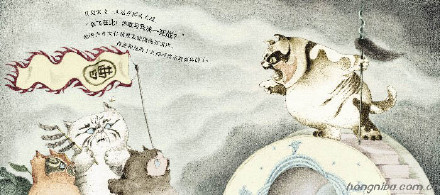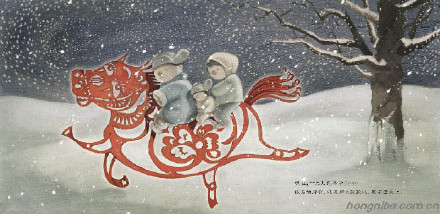
Illustrations for Peking Opera Cats: Changbanpo

Illustration of Paper Horse
Lately, friends have been asking me to recommend summer reading for their children. After carefully considering the recommendations, I’ve discovered that most of them are imported works, which is a bit disappointing and frustrating. So, I’ve set myself an assignment:Select some very Chinese and interesting books to recommend to children. Below is my completed homework.
http://www.hongniba.com.cn/bookclub/images/books/book_20003749_s.jpg
Baby Happy Nursery Rhymes (Ge Cuilin Nursery Rhyme Picture Book)
This large-format book features nursery rhymes written by renowned children’s author Ge Cuilin and meticulously illustrated by children’s illustrator Wu Jinglu. The rhymes are written in gentle, melodious language, and the images are tranquil and beautiful. The illustrations are traditional, reminiscent of a familiar childhood. Suitable for children aged 1–4.
http://www.hongniba.com.cn/bookclub/images/books/book_10005414_s.gif
This is actually a reprint of a set of illustrated storybooks based on ancient Chinese fables, meticulously crafted by the Shanghai Juvenile and Children’s Publishing House. Previously, there was a hardcover edition. It collects and adapts 30 famous ancient fables, featuring illustrations by renowned illustrators such as He Youzhi, Dai Dunbang, Ma Rujin, Wu Jianhua, Yu Li, Wang Xiaoming, and Miao Wei. It has a distinctly Chinese flavor and is well worth collecting for its illustrations alone.
http://www.hongniba.com.cn/bookclub/images/books/book_20003752_s.gif
Almost everyone has heard of the “Eight Immortals,” but fewer and fewer can reel off their names, and even fewer can recount their origins and magical stories. Overall, while this series of books is intended for children, it’s also well-suited for adults. The author, an old farmer, appears to be a researcher, and the stories are well-organized, though not overly vivid, but certainly reliable. The illustrations in this series are absolutely top-notch, created by Mr. Yang Yongqing, whose illustrations for “Ma Liang: The Magic Brush” are perhaps more familiar. They maintain the same traditional style, creating a truly authentic and engaging experience.
http://www.hongniba.com.cn/bookclub/images/books/book_10005554_s.jpg
Chinese Idiom Stories (60 picture books)
Highly recommended! I read and was captivated by it as a child, and I’ve never forgotten it. The comic strips of Chinese idiom stories published by Shanghai People’s Fine Arts Publishing House are so entertaining and informative. I rented them from street vendors as a kid and never read them all. Now, wow, there are 60 books, over 500 idiom stories, all wrapped in a blue box—what a luxury! The new edition also includes a helpful guide, like a search tool, allowing you to search by pinyin and strokes. Amazing! The whole set is like a miniature idiom dictionary in comic book form. Kids today are truly blessed, but they might not experience this…
http://www.hongniba.com.cn/bookclub/images/books/book_20002119_s.gif
The Museum of Great Chinese Classic Stories (6 volumes) (Chinese and English)
The Chinese nation comprises 56 ethnic groups, each with countless stories to tell, each rich and colorful. This so-called “museum” of books only captures a small portion, with each ethnic group offering just one story (two for the Han), but taken together, the collection is quite impressive. This iconic series, meticulously crafted seven or eight years ago by Tomorrow Publishing House, involved the participation of numerous Chinese artists, making it a highly collectible illustrated storybook.
http://www.hongniba.com.cn/bookclub/images/books/book_20002352_s.gif
56 volumes of illustrated Chinese folk tales
This is a truly spectacular collection of folk story picture books, featuring a book for each ethnic group. The large format and beautiful illustrations showcase the stories and customs of each ethnic group, creating a seamless, one-piece scroll. Amazingly, these books were published between 1990 and 1992, yet their quality remains remarkably high today! Mr. Ma Yongjie, the chief planner of this series, currently oversees the mainland publishing efforts of Xinyi Picture Books. He is truly a worthy publisher.
When we rediscovered this set of books, we could describe our feelings as ecstatic. Dr. Wang Lin even wrote an enthusiastic book review for it.Unrepeatable splendor》.
http://www.hongniba.com.cn/bookclub/images/books/book_20003327_s.gif
Picture Book China Series 7 Volumes
This is a set of authentic and original Chinese picture books launched by Tomorrow Publishing House on the occasion of the New Year of 2008. From stories, language to painting styles, it strives very hard to show the connotation of pure Chinese cultural flavor, so the name of the series “Picture Book China” is quite appropriate.
Those familiar with the work of illustrator Xiong Liang will know that many of the works in this series are actually old works, some of which were published several years ago in Taiwan, across the Taiwan Strait, and have been quite popular with readers—after all, there are so few picture books that are “very Chinese.” However, perhaps at this stage, the author’s emphasis on highlighting Chinese culture is too strong, and the interest of the stories themselves (especially for children) is a little pale.
http://www.hongniba.com.cn/bookclub/images/books/book_20003800_s.gif
6‑volume Chinese Picture Book Series
Let me let you in on the fact that I suggested the title “Sentimental China” for this series. I chose “sense” because several of the books are about singing, and some are even singable (like “Su Wu Shepherding Sheep”). I chose “emotion” because this is the illustration style that Mr. Xiong Liang particularly values: moving people with emotion.
Compared to the older works in “Picture Book China,” this series, with its authentically Chinese flavor, has made significant strides in making the stories engaging. For example, the stories in “Peking Opera Cats” are so captivating that they’ll make children laugh out loud (which isn’t always easy). “Lotus Returns” is perhaps the most childlike work, both in its illustrations and its story; and “My Little Pony” is arguably Mr. Xiong Liang’s masterpiece, fully showcasing the artist’s individuality and artistic pursuits.
http://www.hongniba.com.cn/bookclub/images/books/book_20003923_s.gif
Illustrated Chinese Classics (12 volumes) (Phonetic Annotation Edition)
I generally don’t recommend rewrites of classics, as it’s difficult to do well; it’s better to read the originals directly. I recommend this series primarily for its illustrations. The illustrations, created by the Qiyibao Children’s Book Studio, are by brothers Xiong Lei and Xiong Liang. They maintain their distinctive Xiong style, striving to blend traditional Chinese cultural symbols with children’s interests. While there may be moments of success and others of lesser acclaim, it’s at least a commendable attempt. While every reader has their own preferences and choices regarding illustration style, I particularly like the “Classic of Mountains and Seas” and “Liaozhai” (Strange Stories from a Chinese Studio) in this series.
http://www.hongniba.com.cn/bookclub/images/books/book_20002213_s.gif
Chinese Wisdom Masters Series 8 Volumes (Comic Edition)
This series of books is a set of fun pocket comic books. It is based on the thoughts of great Chinese thinkers such as Confucius, Mencius, and Zhuangzi during the Spring and Autumn Period and the Warring States Period, and interprets their immortal wisdom over thousands of years in the form of light-hearted comics.
Using comics to illustrate classic Chinese culture is nothing new; Taiwan’s Cai Zhizhong’s comics are probably classics of this kind. In comparison, Xinlei Publishing’s mainland-originated mini-comic books are a bit simpler, more suitable for younger children, and more engaging.
http://www.hongniba.com.cn/bookclub/images/books/book_20003078_s.jpg
A Good Friend is Coming (Selected Children’s Songs by Li Jinhui, with CD)
This book is a very special edition, featuring a collection of very old children’s songs by a nearly forgotten musician. The accompanying CD also includes recordings of equally old versions of these songs. Mr. Li Jinhui, once revered as the “Father of Chinese Children’s Musical,” created children’s songs (primarily from the 1920s) that have long been widely sung, becoming “century-old classics” of children’s music. Perhaps the most famous of these is “Poor Qiuxiang,” a favorite of mine. Interestingly, despite its age, his songs still sound so familiar.
http://www.hongniba.com.cn/bookclub/images/books/book_20003395_s.gif
Reading Series 8 (Phonetic Phonetic Version of the Chinese Children’s Encyclopedia)
Encyclopedia of China Press is a professional publishing house that specializes in publishing the Encyclopedia of China. It can be said that it has gathered the most professional resources in this field in China.
This “Read Before School” series is a set of encyclopedia readers specially prepared by the Encyclopedia Publishing House for children who are preparing to go to school and those in the lower grades of elementary school. It is very practical, fun, and has very Chinese characteristics.